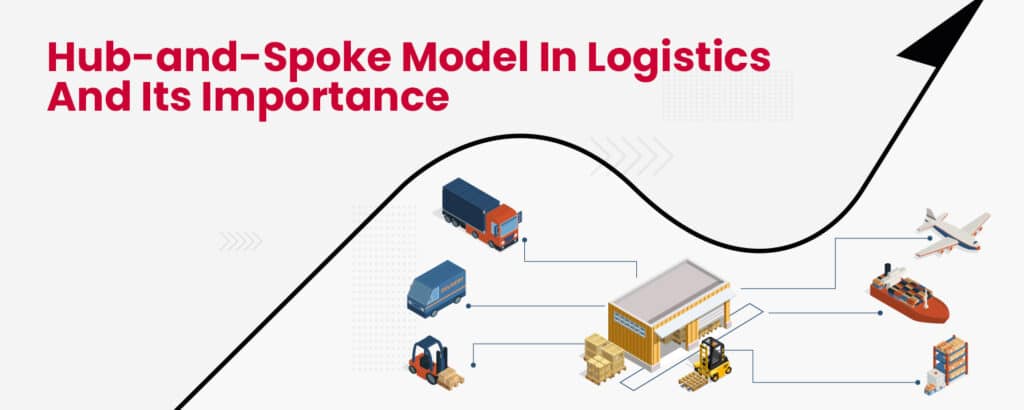As last-mile delivery is becoming a USP for many eCommerce businesses, providing it turns out to be a nightmare for SMBs because the process itself amounts to 53% of the total logistic system. Therefore, an efficient logistics system works as a life-giving-potion for your business in this saturated market and avoids unbearable losses. Talking about efficiency, it is the hub-and-spoke model in logistics that is proven to be efficient for quick eCommerce order fulfillment.
The hub-and-spoke model mimics a bicycle wheel, where all the spokes are centered towards one middle point. Similarly, in the hub-and-spoke model, one centralized hub, warehouse, is strategically placed, and all the routes and delivery destinations are spokes.
It is not a newly discovered model. In fact, the hub-and-spoke strategy is widely used in marketing and popularly in airlines. The best example would be the rapid growth of Indigo airlines through the hub-and-spoke model.
Hub-and-Spoke Model vs Point-to-Point Model

The point-to-point and hub-and-spoke are two different models doing the same thing. These are basically two distinct ends of the connectivity spectrum and are tailored to be used for marketing purposes, distribution (which we’re talking about today), and aviation majorly.
Now there is a lot of controversy on proving which model is best to implement. Both models bring merits and demerits to themselves in the distribution and supply chain.
Point-to-Point Model
Point-to-Point Model, by definition, is a transportation approach where products are transported from point “A” to “B” directly. No stoppage in between, even the routes are not directed. The point-to-point model is best for local businesses that operate in a limited set of locations and have a small customer base.
Let’s understand this with an example:
Suppose there are areas named A, B, C, D. In a point-to-point strategy, the transportation will go as, A to B, B to C, C to D, and you need to connect A to C, A to D, B to A, B to D, and so forth.
To distribute goods through this approach, here you need more than 7 independent connections, and each incurs the cost of infrastructure, and conveyance like a truck, warehouse and inventory management, and other costs.
- This model supposedly reduces travel time as products are directly transported from one place to another without interruption.
- Any delay or damage would not impact the whole logistic system. It will affect that one single delivery.
- Point-to-point can be very expensive, to connect all the points you need to have separate carriers and infrastructure.
The point-to-point system is arguably best for local and small businesses with small operations. But as the business grows, this model will get complex and require lots of money.
Hub-and-spoke Model
On the other hand, the hub-and-spoke model weighs more on the positive side of the spectrum and has more votes as a cost-effective and efficient approach. The model encourages consolidation of all the inventory in one place aka “hub” from where it is timely delivered to different areas (spokes). eCommerce giant Amazon utilizes this model in their FBA service. The FBA sellers deliver their products to Amazon’s fulfillment centers, and from there it is shipped to the customers ASAP.
Let’s have a close look at this model. Suppose, you’re operating in locations A, B, C, D. To deliver goods to all these locations, you’ll establish a hub called “O” from where the goods will be shipped from O to A, O to B, O to C, and O to D.
Here you’ll need to connect “O” to 4 connections only. Which will substantially reduce management costs, conveyance costs, and other associated costs.
- You can achieve economies of scale using the hub-and-spoke model
- The cost of the supply chain is reduced
- Customers can get last-mile delivery
What is Hub-and-Spoke Model in Supply Chain?
The hub-and-spoke model is a centralized logistics and order fulfillment system in the supply chain sanctioning just-in-time shipment and achieving cost efficiency. According to this model, the warehouse is strategically vested, where last-mile delivery to different points is possible.
Let’s understand the hub-and-spoke model with an example:
Let’s say, an eCommerce business caters to customers from A, B, C, D, E, and F areas of a city or state. Now in the hub-and-spoke system, this business will establish a hub, say O, where all product is stored and is at an equal distance from all these areas. Therefore, when the order is received, it can be delivered quickly from O to A, O to B, O to C, O to D, and so on.
This model could be a deal breaker for eCommerce startups competing with established large businesses that do not have much capital to spend on logistics. It will speed up the delivery without investing heavily in the warehouse and inventory management. However, businesses can also cut their expenses in half by partnering with companies like NimbusPost, where you can choose carriers operating with hub-and-spoke models.
Why Hub-and-Spoke Distribution Model?
The hub-and-spoke model offers flexibility with less cost in logistics and supply chain systems. For small or local businesses the supply chain is simplified; they need only one truck or MT to load and deliver goods. However, as businesses scale and expand their operations to different locations, the supply chain rarely gets so simple.
The hub-and-spoke model is designed to simplify the supply chain. You’ll need to establish fewer warehouses and do not need a large fleet of trucks and other transport means enabling faster delivery at low cost and 100% customer satisfaction.
Advantages of the Hub-and-Spoke Distribution Model
Improves workforce productivity
The hub-and-spoke distribution model allows for planning and optimizing delivery routes around the hub linking to different destinations. It improves the workforce and substantially reduces the delivery time compared to the point-to-point model. The product is packed and ready for shipment at one place and delivered to multiple locations within the preferred time. It reduces driving time and increases productivity.
Optimizes route planning and faster deliveries
In the hub-and-spoke model, delivery is executed through the most optimized routes to achieve last-mile delivery to customers. Doing so requires planning and brainstorming on identifying which route is shortest, the traffic pattern, rush hours, and other ground conditions. This allows for a fast and efficient route, leading to customer satisfaction.
Simplifying and lowering logistical expenses
The hub-and-spoke model, because there is one focal point where all the product is packed and transported, makes it cost-effective distribution for eCommerce businesses. You require fewer warehouses for inventory management to reduce the cost of warehouse management, rental, and leasing. The transportation cost substantially decreases, as fewer carriers are needed to deliver products from points “O” to A, B, C, and D. This saves fuel, labor costs, etc.
Hub-and-spoke model airlines example
The hub-and-spoke model gained popularity when several airlines started operating out of a centralized hub and utilizing regional airports as the spoke from which they offer flights. The aviation industry saw a rapid boom through this approach and other industries also got adapted recognizing the growth potential.
The growth of Indigo Airlines would be the best example to understand this. As you know, the aviation industry is one of the toughest to do business in. In the past, we’ve seen the downfall of major airlines like Jet Airways, Kingfisher, and Deccan Air. While existing airlines are struggling to make profits, Indigo has been highly profitable for 10 consecutive years, creating a monopoly in the industry.
How!!
Indigo with implementing its genius cost-cutting strategy, uses the hub-and-spoke model of operation to connect with different locations. With this model, they require fewer planes, and it reduces costs of maintenance, fuel, and labor.
In your wisdom, NimbusPost carrier partners like FedEx, UPS, and others also operate on this model enabling last-mile domestic and international shipping.
Is the Hub-and-Spoke Model ideal for your Supply Chain?
The hub-and-spoke model has many advantages, including better inventory control and greater flexibility. However, logistics companies need to understand whether this structure will fit their supply chain needs before they add it as a new way of doing things.
Most eCommerce companies have to deal with global orders daily and need to handle large transactions quickly. In this context, the hub-and-spoke model can be a must for these types of companies as it allows them to simultaneously scale their operations across multiple locations. Food delivery firms, hyperlocal delivery companies, and other related industries also fall under this category as they usually have high rates of repeat business from more than one customer base within the same region. The decision entirely depends on the nature of your business and your size of operations.
Besides, the hub-and-spoke model is easy to implement and manage; having the same with your distribution network would be the best choice for any enterprise. With warehouses on all sides, this model provides less work for transport companies, reduces fuel consumption, and dramatically decreases journey times.
Other Adaption of the Hub-and-Spoke Model
The hub-and-spoke model is not limited to aviation and logistics. With little brainstorming and iteration, you can achieve efficiency in other types of businesses and industries as well. Distant from airlines and supply chains, intellectuals also forecast the benefits of digital marketing and content marketing.
The marketing industry looks hub-and-spoke strategy similar to “hub” the businesses host their content on a platform like a website and “spoke” where the content is shared, like social media, paid advertisement, emails, etc.
Social Media Application
The social media management tool is adapted as a centralized “hub” where you can draft content and schedule posts to different social media platforms like Facebook, Instagram, Twitter, and LinkedIn, which works as “spoke”.
Having a social media management tool as a centralized hub helps in creating automation and streamlined distribution. It can also monitor analytics and revert to notification, cutting your management efforts in half.
Online Product Management Application
Like a project manager is a hub that controls the success and failure of any project and manages the team, the project management application acts as a centralized hub that assigns tasks to team members, analyzes the performance, keeps account of due dates, and automatically notify team members related to their performance.
Conclusion
The hub-and-spoke distribution model is the best choice to overcome supply chain complexity. The Airlines industry has used it to overcome high costs associated with their operations, the marketing industry has adopted this model to bring efficiency to its operation management, and the eCommerce industry is using it to streamline its logistics and fulfillment system.
However, to use the hub-and-spoke model, it is advised to invest in logistics aggregators who can help in coordinating the entire distribution. NimbusPost, one of the trusted logistic aggregators, can offer you an advanced warehouse and fulfillment system to enable fast delivery and domestic and international door-to-door delivery.




